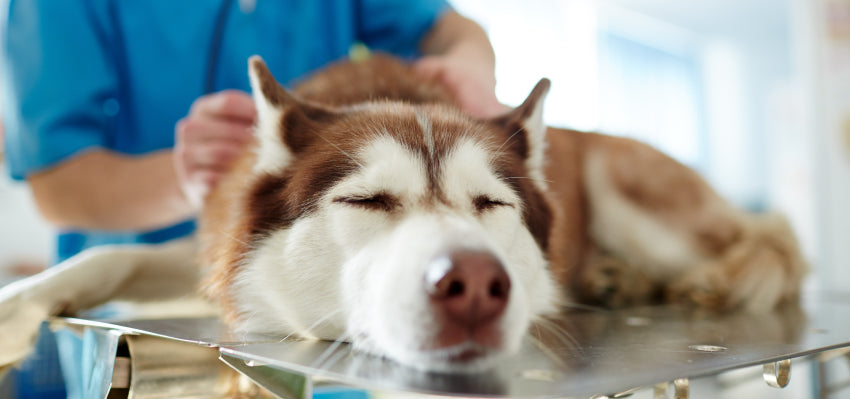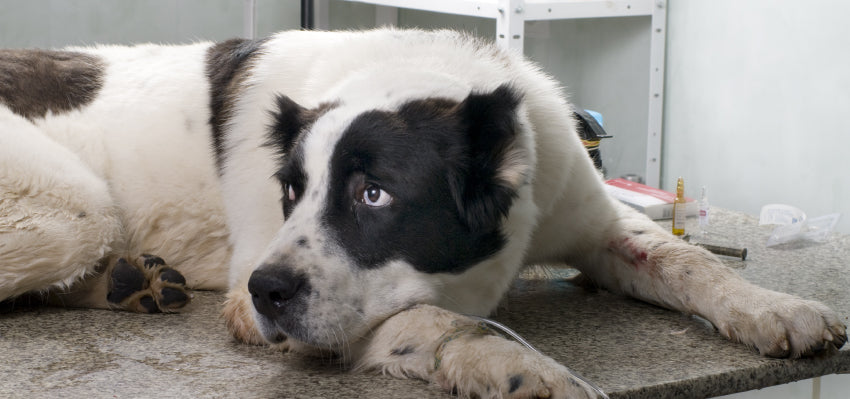Acepromazine for Dogs: Understanding the Effects, Risks, and Natural Alternatives With Bailey's CBD

Acepromazine maleate is a prescription medication that works as a veterinary sedative and tranquilizer. Veterinarians commonly use it to help prepare pets for anesthesia.
While it's available in both tablet form and as an injectable, the U.S. Food and Drug Administration (FDA) has only approved Acepromazine tablets for use in dogs and cats. However, the injectable is cleared for use in dogs, cats, and horses.
Has your vet recommended this medication for your furball? If so, you may have a few questions such as how it works, what to expect, and the recommended Acepromazine for dogs dosage.
Today, we're answering these questions and sharing all the details you need to know!
Table of Contents
- 1. What Is Acepromzine?
- 1.1 Off-Label Use
- 2. How Does Acepromazine Work?
- 3. Risk Factors to Know
- 4. Possible Side Effects of Acepromazine
- 5. Acepromazine for Dogs Dosage
- 6. Frequently Asked Questions
- 6.1 How Long Will the Effects of Acepromazine Last?
- 6.2 What Are the Signs of an Overdose?
- 6.3 How Should I Store Acepromazine?
- 6.4 Are Acepromazine and Xanax® the Same?
- 6.5 Should Certain Breeds Stay Away from Acepromazine?
- 6.6 Are There Any Potential Drug Interactions to Know?
- 7. Potential Alternatives to Acepromazine
- 7.1 CBD Alternatives
- 8. Less Stress, More Calm -- The Natural Way
1. What Is Acepromzine?
Acepromazine is a sedative/tranquilizer used on certain animals. Veterinarians use it as a pre-anesthetic and restraint mechanism for dogs and cats, and as a means to prevent vomiting after surgery. It is not to be used on food-producing animals.
Alternative or brand names of this medication include:
- Acetylpromazine
- ACE
- ACP
- Aceproject
- Aceprotabs
- PromAce®
Acepromazine can be administered in one of two ways:
- As an injection
- As a tablet by mouth
Injection is the most common method, performed in a hospital setting. When injected, Acepromazine can be administered in your pet's muscle, under their skin, or directly into their vein. When given orally, the tablets should be taken 45 minutes before a surgical event or procedure.
1.1 Off-Label Use
If Acepromazine is used in any way or on any other species than what's explicitly listed on its label, that use is known as "off-label" or "extra-label". This is a common practice in veterinary medicine, but it's important to listen closely to what your vet says during the process. Their instructions may deviate from what's listed in the instructions.
For instance, a vet might prescribe Acepromazine as a type of secondary treatment for a cat suffering from a urinary blockage. Or, they may use it to help treat laminitis in horses. This is a condition that causes inflammation and damage in the tissue that separates the horse's hoof from the underlying coffin bone.
In that case, Acepromazine can help reduce the frequency of painful vasospasms that occur with laminitis. It works to dilate small blood vessels in their hooves, which helps improve blood circulation.
2. How Does Acepromazine Work?
In technical terms, Acepromazine is categorized as a phenothiazine neuroleptic. While this term is a little complicated, it simply means that the medication alters the chemicals in your pet's brain, which can effectively change their behavior.
When veterinarians administer a dose of Acepromazine, it has a quick-acting depressant effect on their central nervous system. This is the system of neurons that includes your pet's brain stem, cerebellum, cerebrum, and spinal cord.
While the mechanism of action isn't known, this medicine is thought to block receptors of dopamine in your pet's brain. Dopamine is the primary chemical used for sending signals and communication between cells.
When their central nervous system functions are depressed, your pet may experience feelings of physical sedation and muscle relaxation. In addition to a general look of sleepiness, you may also notice that your pup or kitty seems less anxious or jittery. This is because Acepromazine also helps reduce spontaneous bouts of activity.
When given before surgery, Acepromazine may lower the amount of general anesthesia that your pet requires. However, it does not have any pain-relieving effects.
3. Risk Factors to Know
As mentioned, food-producing animals such as poultry or cattle should not take Acepromazine. In addition, dogs that have a mutation in their MDR1 gene (ABCB1-1delta) may be more sensitive to this medication. Dogs with this specific genetic variant can experience serious and even life-threatening complications when taking specific medications at certain doses.
If your veterinarian has identified this mutation in your pup, they may recommend alternative medications. Or, they may be able to safely administer Acepromazine at a lower dosage.
Other risk factors that could render this medication unsafe for your pet include:
- Exposure to insecticides or pesticides (organophosphates, procaine, or strychnine)
- Taking central nervous system medications (such as Phenobarbital)
- Significant heart disease
- Shock
- Low blood pressure
- Severe dehydration
- Anemia
- Tetanus
There are also conditions that can make Acepromazine relatively unsafe for your pet. If any of these apply, your veterinarian may recommend moving forward with the medication, but using it with caution:
- Heart disease
- Liver disease
- Seizure disorders
- Blood-clotting conditions
- Low platelets
- Debilitation
- Pregnancy
- Lactation
- Older age
This medication is also not recommended for very young animals, as their central nervous systems are still developing.
4. Possible Side Effects of Acepromazine
Once your fluffy pal has taken a dose of Acepromazine, it's helpful to know what to expect. The most important thing is to ensure your pet is carefully and consistently monitored after the medication is administered.
Typically, it's given in a veterinary hospital setting, where professional teams are on hand at all times. Some of the most common Acepromazine side effects to note include:
- Fatigue and lethargy
- Muscle weakness
- Increased heart rate
- Disorientation and confusion
- Low blood pressure
- Aggression and hyperactivity
- Chewing
- Aggression
- Reverse sneezing
- Pinkish to red/brown urine
- Decreased tear production (mostly in cats)
- Temporary pain at the injection site (if injected into the muscle)
In some cases, more serious reactions such as seizures can occur. For example, low blood pressure can lead to cardiovascular collapse if it's severe. If your pet is allergic to the medication and has an adverse reaction, you may notice any of the following signs:
- Difficulty breathing
- Inflamed tongue, lips, or face
- Hives
If these side effects occur, it's critical to seek emergency medical care as quickly as possible. This is why the medication must always be administered in the presence of a veterinary professional.
While your pet is under the effects of Acepromazine, your vet will regularly monitor their heart rhythm, heart rate, and blood pressure to make sure they stay within normal levels. They'll also keep a close eye on their body temperature, especially if the local room temperature is warmer or colder than normal.
5. Acepromazine for Dogs Dosage
There isn't a standard Acepromazine dosage that will apply to all pets. It's important to follow the instructions on the medication's label, as well as the instructions from your veterinarian. If your pet is receiving the medication via injection, this will take place in a hospital.
If they're taking the tablet form, you may be able to give the tablet from home, or at the vet's office. They will need to receive it at least 45 minutes to one hour before the surgery takes place. In tablet form, Acepromazine is available in 10mg and 25mg tablets, and each tablet is quarter-scored.
The standard dosage for both dogs and cats is 0.25mg to 1mg per pound of body weight.
6. Frequently Asked Questions
Let's take a look at some of the most common concerns and questions that pet parents have before giving their four-legged pal Acepromazine.
6.1 How Long Will the Effects of Acepromazine Last?
In some pets, this medication can last for up to 24 hours after it's administered. However, the typical timeline is much shorter. If your pet takes the oral tablet version of Acepromazine, the effects normally last between one and four hours.
6.2 What Are the Signs of an Overdose?
Worried that your pet received too much Acepromazine? If so, it's important to contact your veterinarian as soon as possible. Elevated levels of this medication can lead to excessive depression in your pet's central nervous system.
When this happens, the following serious side effects could occur:
- Acute sedation or lethargy
- Pale gums
- Severe muscle weakness
- Shallow breathing
- Agitation
- Seizures
- Collapse
If your pet has taken an inappropriate dose of Acepromazine, seek emergency veterinary care immediately.
6.3 How Should I Store Acepromazine?
If your vet gave you Acepromazine tablets to take home, store the medication at a controlled temperature between 68 and 77 degrees Fahrenheit. Keep the medication in a cool, dark place where it will not be exposed to high levels of heat or light.
6.4 Are Acepromazine and Xanax® the Same?
Due to its off-label use as a means to control agitation and anxiety, you may wonder if Acepromazine is the same thing as Xanax. The answer is no.
While some of their effects can be similar, Xanax is the brand-name version of alprazolam. This medication belongs to a group of sedatives called benzodiazepines.
Like Acepromazine, Xanax is often prescribed off-label to pets who are suffering from anxiety or stress. However, Acepromazine is classified as a phenothiazine, which is a different type of sedative.
6.5 Should Certain Breeds Stay Away from Acepromazine?
This medication could cause unwanted side effects in certain brachycephalic dog breeds. These are breeds that have short muzzles and noses, as well as flat faces. While these features can be absolutely adorable, they can also restrict a dog's breathing.
Acepromazine may not be appropriate for large brachycephalic dogs such as boxers and greyhounds. If administered at larger doses, its effects could be stronger and last longer than necessary or safe. Your veterinarian will be able to guide you on whether this is a good choice for your pet.
6.6 Are There Any Potential Drug Interactions to Know?
Be sure to tell your vet if your pet is currently taking any kind of herbal remedies, vitamins, or supplements. These may contain ingredients that could interact negatively with the active ingredients in Acepromazine.
It's also important to exercise caution when taking this medication if your pet is already on any of the following medications:
- Acepromazine
- Acetaminophen
- Anti-diarrhea medicine
- Antacids
- Cisapride
- Central nervous system depressant
- Dopamine
- Emetics (poison treatments)
- Fluoxetine
- Hypotensive agents
- Metoclopramide
- Metronidazole
- Nonsteroidal anti-inflammatory drugs (NSAIDs)
- Opiates
- Organophosphate agents
- Phenobarbital
- Phenytoin
- Procaine
- Propranolol
- Quinidine
- Sucralfate
While taking these medications doesn't automatically mean your pet can't take Acepromazine, it's important to be up-front with your vet to avoid any negative interactions.
7. Potential Alternatives to Acepromazine
If your vet recommends Acepromazine to relax and calm your pet before anesthesia and surgery, then it's important to follow those instructions. However, there are certain off-label applications in which natural alternatives, such as CBD products, might be gentler and more appropriate.
One example is using Acepromazine to calm your pet before an anxiety-inducing event, such as:
- A ride in the car
- A veterinarian examination
- A trip to the groomer
If your pet's nerves are tightly wound and they appear agitated, you may think an injection or tablet of Acepromazine will help successfully soothe them.
While this might be the case, it's not your only option.
7.1 CBD Alternatives
If you'd prefer to relax your pup in a more natural way, why not try one of our CBD Dog Treats instead? A treat like our Calming CBD Yummies can help them feel more relaxed, calm, and at ease, taking effect in just 30 to 60 minutes.
All of our treats are veterinarian-formulated and third-party lab-tested. They're also grain-free, soy-free, and completely vegan. You can choose from two different strengths, as follows:
- 3mg CBD per chew for small to medium breeds
- 6mg CBD (extra strength) per chew for large breeds
If you're gearing up to take your pup on a ride, these are a great way to ease their nerves and help them make the transition with ease. In addition to dog treats, we also offer CBD Oil for both dogs and cats.
An easy-to-use dosage guide is attached to every bottle. All you have to do is add the appropriate amount to their food bowl and you'll notice the difference. This oil promotes a sense of calm and relaxation, making it a great way to relax and de-stress your agitated pet.
8. Less Stress, More Calm -- The Natural Way
When used as a pre-anesthetic in a veterinary setting, an Acepromazine for dogs dosage can be incredibly useful. As it suppresses your pet's central nervous system, it can help ease feelings of nervousness, restlessness, and anxiety. This can make those pivotal moments before surgery easier to navigate.
However, if you're thinking about using this medication to help your dog feel generally less anxious, we suggest starting with a gentler and more natural solution, such as our CBD products, instead.
Harnessing the power of CBD, our treats, oils, and topicals are designed to help your pets feel more relaxed and at ease, right from the first dose. Check out our Calm Collection for more!
These products have not been evaluated by the FDA and are not intended to diagnose, treat, cure, or prevent any disease.



















